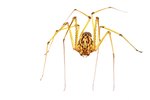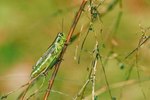Praying mantises don't go through a larval stage. They hatch as small sized versions of the adults and shed their skins as needed as they reach adulthood. They'll shed their skin seven times before becoming a sexually mature adult. You can tell when a praying mantis is about to molt because she'll lose her appetite and hang motionless upside down in her cage. Just before molting, a juvenile mantis also gets swollen wing buds where her wings will eventually grow.
The No-Food Diet
A mantis stops eating and drinking several days before a molt to thin the body for an easy exit from her old skin. Should prey approach her, she'll bat them away with a front leg. Once she begins to emerge from her skin, she'll be vulnerable to attack from crickets or other insects looking to feast on her tender new flesh. Other signs she's about to molt include hanging upside down motionless and turning a pale brownish color as her skin loosens.
How to Help
At the first sign of molting, remove all prey from her cage. As she emerges from her old skin, she is most vulnerable to attack or injury. Once she's hanging upside down, don't move the cage or tap the glass. Should she fall before her new skin hardens, she will die trapped in her own skin. Wait 48 hours before replacing the prey in her cage to give her skin time to harden.
Writer Bio
Indulging her passion for vacation vagary through the written word on a full-time basis since 2010, travel funster Jodi Thornton-O'Connell guides readers to the unexpected, quirky, and awe-inspiring.




